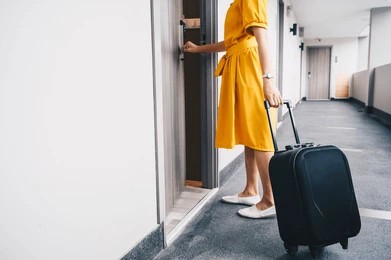
30 Oct Beyond the Hotel Walls: What Our Cities Reveal About Women’s Safety
When one travels to a new city, you often imagine new experiences such as exploring local food, discovering new neighbourhoods, or enjoying the small moments that make travel memorable. But for many women, that excitement comes with a constant layer of calculation: Is my hotel in a safe area? Can I walk to the nearest café? Will I feel safe coming back at night alone?
These questions became all too real recently when two members of the Australian women’s cricket team were inappropriately touched while walking to a café near their hotel in Indore during the 13th Women’s World Cup. The incident is a painful reminder that women’s safety in public spaces, even those just outside a hotel, shapes their overall experience of travel.
Most hotels today highlight safety features such as keycard access, CCTV coverage and a 24-hour reception. While these are important, they only address the safety inside the building. For women, a sense of comfort and confidence starts much earlier, from the time of booking and on the street leading to the hotel.
In 2020, we conducted a survey of 335 women to understand their experiences of traveling alone, for work or leisure. 80% of women said that well-lit streets around a hotel is the most important factor for external safety, followed by 74% who wanted easy access to public transport, and 73% who valued the presence of shops and people nearby in making them feel safe.
These three priorities of lighting, access to public transport, and visibility (street activities) are central to Safetipin’s core parameters for measuring safety. Together, they speak to one larger truth: women feel safer where there are eyes on the street, and when streets are designed as shared spaces promoting a sense of belonging and inclusion for all.
Our work and findings show that a woman’s experience of safety during a hotel stay is shaped by five broad themes:
- Hotel booking: The journey begins before check-in. Women look at customer reviews, star rating and location of the hotel as deciding factors.
- Hotel common area facilities: Lighting and CCTV cameras are not just amenities, they’re active contributors to a woman’s feeling of comfort in the hotel.
- Hotel room facilities: 24×7 power backup and wifi, emergency call buttons, presence of door chains are crucial for how safe women feel inside their hotel rooms.
- Staff protocols: Most hotels have trained staff, however responsive and attentive staff significantly enhance a woman’s experience in a hotel. This includes asking before escorting a woman to her room or keeping the door open when delivering room service.
- Surrounding built environment: The design of and activity on streets outside a hotel and the access to active streets or public transportation, are integral to feeling safe.
These factors together remind us that safety is holistic. It is not just a checklist within the hotel, but a continuum that begins when a woman books her stay and extends to every step she takes outside its doors.
The incident in Indore underscores something Safetipin has observed repeatedly in cities across the world: a woman’s sense of freedom and safety depends as much on the city as on the building she’s in. A well-rated hotel can still feel unsafe if the street outside is dark or empty. Conversely, even a modest property in a lively, well-lit neighbourhood can feel far more welcoming. This connection between public space safety and women’s travel experiences is why it’s essential for hotels, urban practitioners, and local authorities to see themselves as part of the same ecosystem. Women don’t experience safety in silos, their comfort moves between private and public space.
At Safetipin, we believe that a truly safe city is one where women, local or tourists, can make decisions without fear, move freely, and engage with their surroundings. As conversations around travel safety evolve, it’s time we look beyond the building and pay attention to what surrounds it, because the journey between a hotel room and a café, a restaurant, or a stadium should never be the most dangerous part of a woman’s day.

